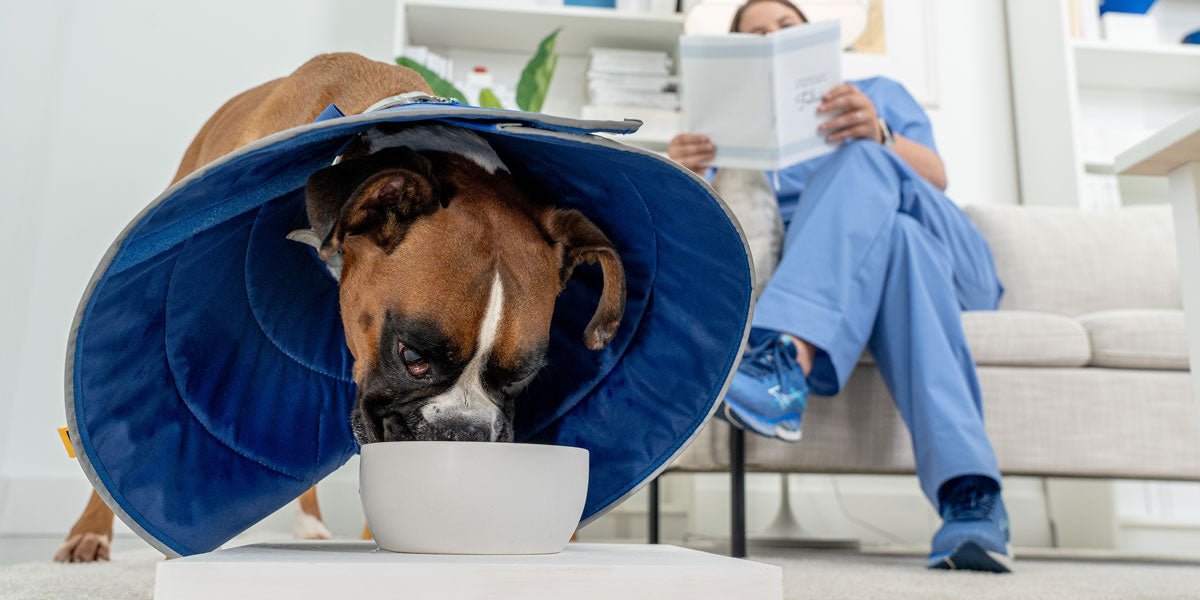
How to Keep Playtime Safe and Healing on Track
If your dog is wearing the infamous “cone of shame,” you’re likely dealing with a wound, hot spot, surgery site, or skin condition that needs time to heal. But that doesn’t stop your pup from wanting to play! So you may be wondering: Can my dog still play with the cone on?
The short answer is yes but with care. Play is important for mental stimulation and emotional wellbeing, but during recovery, not all activities are safe. In this post, we’ll explore how to play safely with your dog in an e-collar, what to watch out for, and when it’s best to pause the fun and consult your veterinarian.
Is It Safe for Dogs to Play in a Cone?
Dogs can absolutely play while wearing a cone; but what kind of play, how intense it is, and what they’re recovering from all matter. The cone itself isn’t the problem, it’s what might happen because of the play.

If your dog is recovering from:
- Hot spots or skin irritations
- Gentle play is usually okay, but avoid roughhousing or running that could cause friction or sweating, which worsens irritation.
- Surgery (like spay, neuter, or orthopedic procedures)
- Physical activity should be limited, especially in the first 10–20 days. Sometimes even longer depending on vet's recommendations. Too much movement can strain sutures or delay healing.
- Injuries (like sprains or wounds)
- Supervised, low-energy play may be fine later in the recovery window. Always follow your vet’s specific guidelines.
How to Play with a Dog Wearing a Cone
To make playtime enjoyable and safe during recovery, try these cone-friendly activities:
-
Puzzle Toys & Treat Dispensers
Keep their mind active without overexerting their body. Choose wide or low-profile toys that can fit under or around the cone. -
Light Tug with a Soft Toy
Hold the toy lower or closer so they don’t strain their neck or get frustrated trying to grab it. If they're really pulling forcefully, "give in" and let them win a little more easily. -
Sniff & Seek Games
Hide treats around the house or in a snuffle mat to let your dog engage their nose and brain; no zoomies required. -
Training Drills
Practice sit, stay, or shake to build confidence and focus. Use positive reinforcement and keep sessions short and fun.
Things to Be Cautious About
While play is good for the soul, here’s what to avoid during cone time:
- Rough Play or Running: Can pull stitches or irritate healing tissue.
- Dog Parks or Group Play: Other dogs may react poorly to the cone, and accidental bumps or bites could cause harm.
- Small Toys: The cone may block their ability to grab or chew smaller toys safely.
- Overheating: Some cones reduce airflow around the neck. Take supervised breaks and offer water frequently.

What If My Dog Seems Frustrated?
It’s normal for pets to feel a bit out of sorts at first. If your dog is pawing at the cone, refusing to play, or seems anxious, consider these tips:
Try a Comfort-Focused Cone:
Soft or padded options like the KVP Calmer™ or KVP KONG™ Cloud can reduce stress and make moving (and playing!) easier.
Shorter Play Bursts: Limit activities to 5–10 minutes at a time during early recovery.
Snuggles Count as Play: Don’t underestimate the power of gentle touch, brushing, or just sitting together.
Always Check with Your Veterinarian
Before resuming any kind of play, especially after surgery or injury, talk to your vet. Every healing plan is different depending on the condition, procedure, and your dog’s age or breed.
Ask questions like:
- When can my dog safely resume activity?
- Are there specific movements to avoid?
- What signs of overexertion should I look out for?
Following a vet-approved plan helps you balance rest and stimulation while avoiding setbacks.

Final Thoughts
Yes, your dog can play in the cone of shame, but they’ll need your help to do it safely. With the right toys, gentle activities, and a little creativity, playtime can still be a bright spot in your pup’s healing journey.
Because recovery doesn’t mean joy has to stop, it just means we play a little smarter.